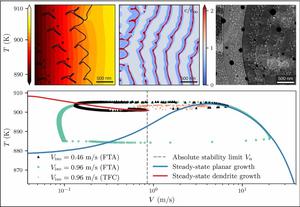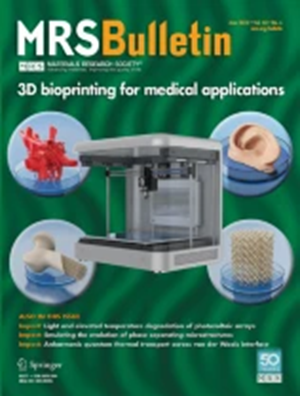Microstructure development during rapid alloy solidification
IF 4.1
3区 材料科学
Q2 MATERIALS SCIENCE, MULTIDISCIPLINARY
引用次数: 0
Abstract
Solidification processing of structural alloys can take place over an extremely wide range of solid–liquid interface velocities spanning six orders of magnitude, from the low-velocity constitutional supercooling limit of microns/s to the high-velocity absolute stability limit of m/s. In between these two limits, the solid–liquid interface is morphologically unstable and typically forms cellular-dendritic microstructures, but also other microstructures that remain elusive. Rapid developments in additive manufacturing have renewed the interest in modeling the high-velocity range, where approximate analytical theories provide limited predictions. In this article, we discuss recent advances in phase-field modeling of rapid solidification of metallic alloys, including a brief description of state-of-the-art experiments used for model validation. We describe how phase-field models can cope with the dual challenge of carrying out simulations on experimentally relevant length- and time scales and incorporating nonequilibrium effects at the solid–liquid interface that become dominant at rapid rates. We present selected results, illustrating how phase-field simulations have yielded unprecedented insights into high-velocity interface dynamics, shedding new light on both the absolute stability limit and the formation of banded microstructures that are a hallmark of rapid alloy solidification near this limit. We also discuss state-of-the-art experiments used to validate those insights.

合金快速凝固过程中的微观结构发展
结构合金的凝固加工可在极宽的固液界面速度范围内进行,速度跨越六个数量级,从微米/秒的低速宪法过冷极限到米/秒的高速绝对稳定极限。在这两个极限之间,固液界面在形态上并不稳定,通常会形成蜂窝状树枝状微结构,但也会形成其他难以捉摸的微结构。增材制造技术的快速发展再次激发了人们对高速范围建模的兴趣,而近似分析理论对高速范围的预测有限。在本文中,我们将讨论金属合金快速凝固相场建模的最新进展,包括简要介绍用于模型验证的最新实验。我们介绍了相场模型如何应对双重挑战:既要在与实验相关的长度和时间尺度上进行模拟,又要纳入在快速凝固时成为主导的固液界面非平衡效应。我们介绍了部分结果,说明相场模拟如何为高速界面动力学提供了前所未有的洞察力,为绝对稳定极限和带状微结构的形成提供了新的启示,而带状微结构是该极限附近合金快速凝固的标志。我们还讨论了用于验证这些见解的最新实验。
本文章由计算机程序翻译,如有差异,请以英文原文为准。
求助全文
约1分钟内获得全文
求助全文
来源期刊

Mrs Bulletin
工程技术-材料科学:综合
CiteScore
7.40
自引率
2.00%
发文量
193
审稿时长
4-8 weeks
期刊介绍:
MRS Bulletin is one of the most widely recognized and highly respected publications in advanced materials research. Each month, the Bulletin provides a comprehensive overview of a specific materials theme, along with industry and policy developments, and MRS and materials-community news and events. Written by leading experts, the overview articles are useful references for specialists, but are also presented at a level understandable to a broad scientific audience.
 求助内容:
求助内容: 应助结果提醒方式:
应助结果提醒方式:


